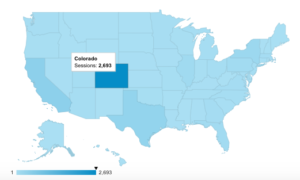When it comes to analyzing the success of a website, data is our friend. Data allows us to see how visitors find a website and how they engage with it once they get there. This gives us clues about what is happening and did happen on any website – but what about the data that is missing?
In one of the most beloved Sherlock Holmes stories, “The Adventure of Silver Blaze”, Holmes solves a crime based on what was missing from the evidence, rather than the evidence itself. He called this “the curious incident of the dog in the nighttime.” The pure fact that the dog did not bark during the crime led him to believe that it was committed by someone the dog was familiar with. (cool!)
This absence of an expected fact provided more insight into the event and might have been missed if they were solely looking at what did occur.
The point is to not just find meaning in why certain events happened, but also in why something did not happen. What is the norm on your website, and what more could you be doing?
A good exercise is to look at the data and try to complete this sentence:
“The fact that [blank] did not happen means [blank].”
It is simple, yet effective.
Here is an example:
You are analyzing data from Google Analytics and realize that a lot of your website visitors are new and have never been to your website before. The percent of new visitors is at an all-time high, meaning visibility is at an all time high! Great!
Or is it? Acquiring new visitors is always a positive trend in website traffic, however, this information does not tell a whole story by itself. What about those returning visitors? Did the quantity of these returning visitors go down, or did the percent of new visitors just go up? Does your website only cater to new visitors, with no incentive for visitors to return and engage with your brand further? What more could you be doing to build a lasting connection with every single customer?
Here we go:
“The fact that the majority of visitors are not returning, means that they do not see us as a lasting resource.”
First you need to decide what it means for visitors to not be returning to your site. This isn’t necessarily a bad thing, depending on the goals of your website, however, these are important points to address.
Even if your product or service is a one-time or intermittent endeavor for consumers (such as wedding arrangements or appliance repair), there may still be many benefits to catering to past customers. Becoming an ongoing resource for potential and past customers will build value, trust, and possibly referrals. This can indirectly support your brand and lead to monetary growth in the future. Also, reevaluating the experience of past customers is a great way to learn how to improve your website and capture more business.
Fun, right?
This one question opens up a whole new conversation about online strategy and whether or not there is an opportunity that is being missed. This is just an example of new vs. returning visitors, but Google Analytics provides so much more data that can be looked at in this way and will launch a lot of interesting and necessary conversations about the success of your website and online presence.
Focus equally on what you should continue doing vs. what you should stop/start doing. You can start by looking at the the quantity of visitors, however, quantity does not always mean quality leads. Take a look at a few examples of data points that you could dive deeper into in order to gain a better understanding of what your website visitors are, or are not, doing:
 Geography: If the majority of your website visitors are within your service area, that is a great sign! What are the most popular locations, where are the other visitors coming from, and why? This is a good time to define what other locations you should, and could, be targeting. If your company services the Greater Denver area but there are no visitors located in Englewood finding your website, there must be a reason:
Geography: If the majority of your website visitors are within your service area, that is a great sign! What are the most popular locations, where are the other visitors coming from, and why? This is a good time to define what other locations you should, and could, be targeting. If your company services the Greater Denver area but there are no visitors located in Englewood finding your website, there must be a reason:
- Is there a competitor in that area that has an overlapping service area?
- How can you better reach visitors who might work in Denver, but live in outlying counties?
- Might there even be an opportunity to gain business from nearby states?
- Number of Days Since Last Visit: This data point provides great insight into the “buying decision process” of your consumers and if they view you as an ongoing resource. If the majority of your visitors are coming to your site and returning a week later, what information are they looking for?
- What are the most popular exit pages? Meaning, at what point in their website visit are visitors deciding they have enough information to leave and not return?
- Are they getting the right information on that one visit and are enough visitors converting on that first visit?
- How often do you think visitors should return to your website and why? Once a week? Three times in one week until they convert? Once a month?
- If your product or service requires a little more research, how can you incentivize or remind visitors to return?
- Bounce Rate: Google Analytics provides a site-wide average bounce rate, as well as the bounce rate of each individual page. Bounce rate is when a visitor lands on that page, then leaves the site with hardly any interaction. Looking at each individual page can tell you a lot about your first impression with visitors.
- Does it make sense that these visitors are even landing on this page to begin with?
- Is there, or should there be, a call to action on this page that will lead visitors further into the site?
- Is there very important information that you have on the homepage and the contact page that might be helpful for visitors who land on an internal page to know or have access to?
There are so many different tools for collecting and examining data, but that doesn’t replace human analysis and intuition. The data is merely just a jumping off point that allows you to further scrutinize and evaluate what it all means. Data analysis is not that far removed from Sherlock Holmes’ deductive reasoning – using information to tell a story – so all you have to do is find the right pieces and reveal any holes. The story is in there, you just have to find it. And trust me, there is always so much more of the story to be told.




 Geography: If the majority of your website visitors are within your service area, that is a great sign! What are the most popular locations, where are the other visitors coming from, and why? This is a good time to define what other locations you should, and could, be targeting. If your company services the Greater Denver area but there are no visitors located in Englewood finding your website, there must be a reason:
Geography: If the majority of your website visitors are within your service area, that is a great sign! What are the most popular locations, where are the other visitors coming from, and why? This is a good time to define what other locations you should, and could, be targeting. If your company services the Greater Denver area but there are no visitors located in Englewood finding your website, there must be a reason: